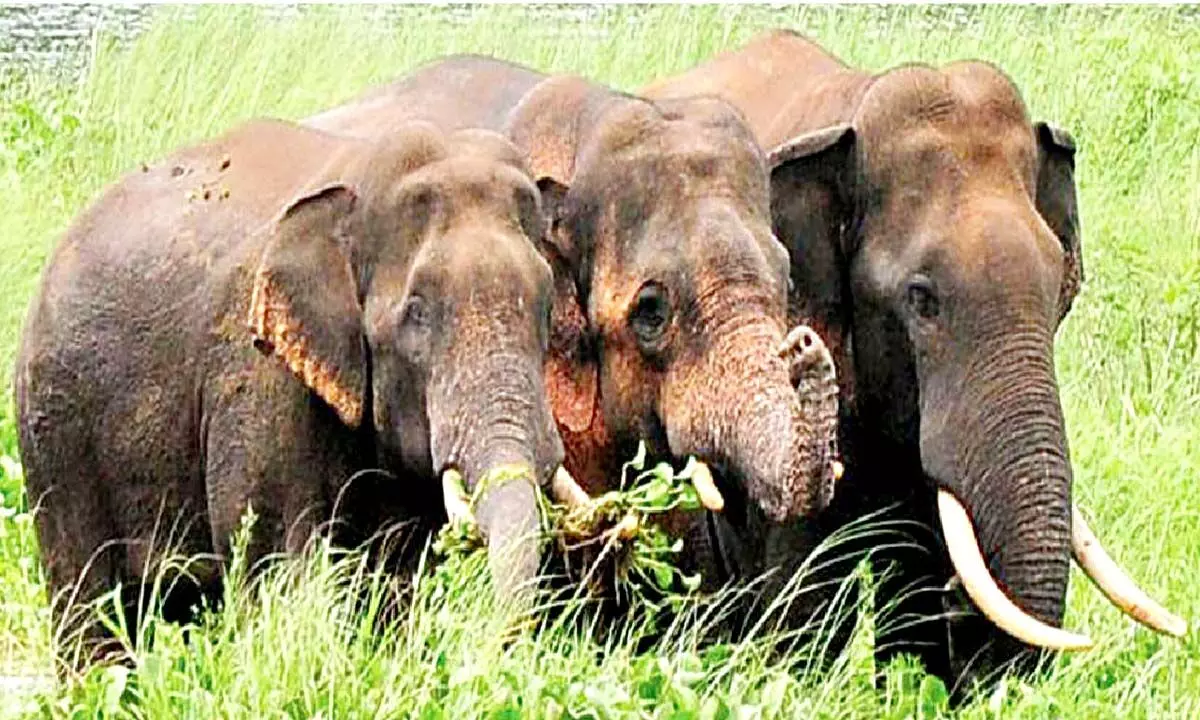Live
- SRKR College bags IEI Engg Excellence Award
- Rozgar Mela a favourite programme of PM Modi: Bandi Sanjay
- Multi-stakeholder efforts needed to improve school facilities
- Be part of transforming India into Viksit Bharat: Kishan Reddy
- Now, tackle pest menace in hostels with LED lights
- Hyderabad: Students protest over appointing Physics prof as EdCET convener
- Young doctors urged to work for healthy community
- Bhavani Deeksha Viramana continues
- Sridhar Babu hardsells key sectors to Malayasia
- Health Min Damodar Raja Narsimha holds meet to improve infra in govt hosps
Just In
Tri-state elephant census held to know population dynamics


- It reveals that 90-110 elephants are there in the Chittoor district, including an equal number of migrants
- It is proposed to construct 3.5 km long underpasses on the Palamaner-Mogili ghat section
- It includes a 1.9 km long underpass, potentially the longest in the country
Tirupati: Theforest departments of Andhra Pradesh, Karnataka and Tamil Nadu collaborated on a synchronised elephant census from May 23 to 25 in the tri-state region.
The goal was to understand elephant population dynamics and identify conflict zones. The census found that approximately 90-110 elephants live in the former Chittoor district.
According to the Wildlife Institute of India’s 2023 report, ‘Elephant Corridors of India’, there are 150 identified elephant corridors nationwide. Andhra Pradesh hosts two key corridors: the Rayala elephant reserve corridor and the tri-junction corridor.
The Rayala corridor, supporting 50-60 elephants, connects Koundinya Wildlife Sanctuary to Sri Venkateswara National Park and is threatened by national highways and the proposed Bengaluru-Chennai expressway. The tri-junction corridor, used by 15-20 elephants migrating from Tamil Nadu and Karnataka, faces threats from the Krishnagiri-Palamaner national highway and the Bengaluru-Chennai railway line.
In response to recent elephant attacks and crop damage, forest officials planned a comprehensive census to identify high-density areas and allocate resources to mitigate human-elephant conflicts. The census employed a systematic three-day approach, including block sampling, line transect exercises, and waterhole direct counts.
On the first day, officials conducted block sampling in areas with high elephant populations, covering five sq km sample blocks.
The second day involved line transect exercises to record elephant dung piles, while the third day included waterhole direct counts with photographic documentation of herd sizes, ages, and genders. The census also aimed to document forest cover, land use and current elephant distribution and density.
The census, conducted in the forest areas of Chittoor East and West, Kuppam, Palamaner and other ranges of the Chittoor district, estimated the presence of 90-110 elephants along with an equal number of migratory elephants.
Chittoor district forest officer C Chaitanya Kumar Reddy noted an annual increase in elephant numbers, with herds migrating from Karnataka and Tamil Nadu.
The census highlighted significant conservation challenges, particularly human-elephant conflicts, including risks of electrocution and road accidents in forest-adjacent villages. Illegal electric fences and sagging power lines exacerbate these risks, especially near migration corridors like Rayala.
To address these issues, the forest department has proposed constructing 3.5 km long underpasses on the Palamaner-Mogili ghat section of the Tirupati-Bengaluru highway. This project includes a 1.9 km long underpass, potentially the longest in India, to reduce wildlife accidents. Proposals have been sent to central authorities, and work is set to begin soon, according to the DFO revealed.

© 2024 Hyderabad Media House Limited/The Hans India. All rights reserved. Powered by hocalwire.com






